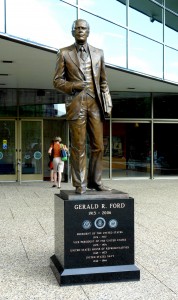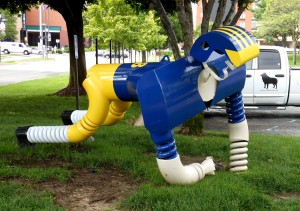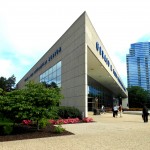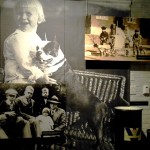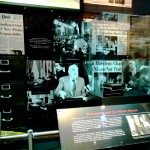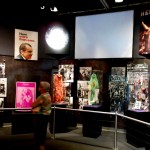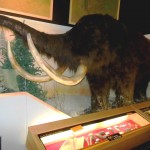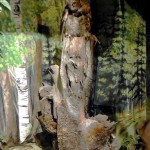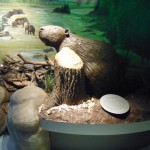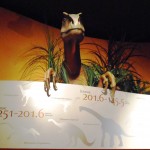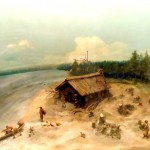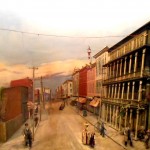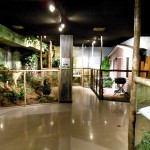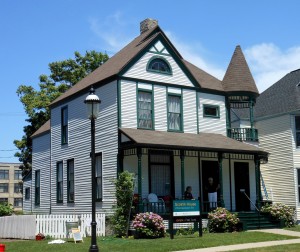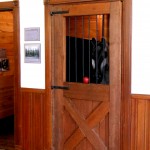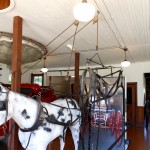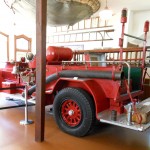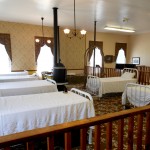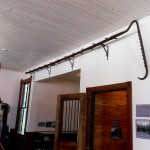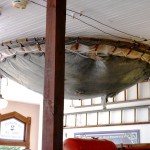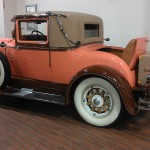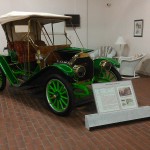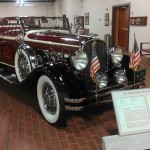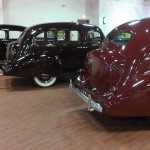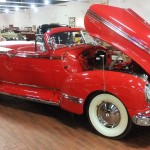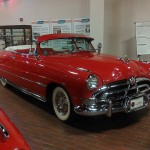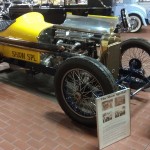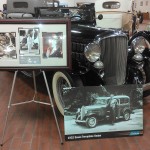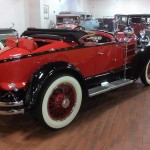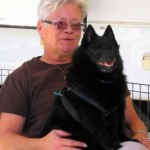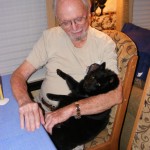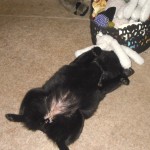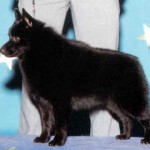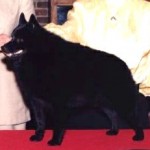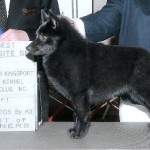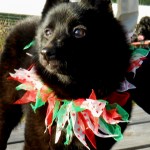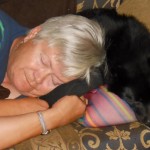We still had four or five days to kill until our due date at the next Rally in Mackinaw. Grand Rapids was a comfortable midpoint, and we enjoyed the opportunity to visit yet another Presidential museum. Our 38th President’s heritage is divided. Grand Rapids, his home town, is the location of the Gerald R. Ford Presidential Museum, while his Library is on the campus of his undergraduate alma mater, UMichigan, in Ann Arbor. They are jointly administered. The museum is housed in a grand architectural concept near downtown, its front lawn guarded by an abstract Ford in football regalia. Captain of his high school football team, outstanding college player elected to the national all-star team, and recipient of contract offers from two NFL teams, he opted, instead, for boxing and football coaching positions at Yale, hoping to get into their law program. Completing his LLB in the top quarter of his class in 1941, he returned to Grand Rapids and briefly worked as a lawyer. But a year later he became an ensign in the Navy Reserve. He served aboard the aircraft carrier USS Monterrey and almost lost his life — not in battle but when the ship was caught in a typhoon in the Philippine Sea, caught fire and was severely damaged. After his discharge in 1946, he returned to Grand Rapids to practice law but was soon inspired by his adoptive father, the state Republican chairman, to run for Congress. He was elected to 14 terms, each with over 60% of the vote. While he longed to be Speaker of the House, the best he accomplished was Minority Leader, a post he held for 8 years before being tapped by President Nixon to replace Spiro Agnew as his right-hand man. The rest, as they say, is history.
- A gem of an exterior
- The younger Gerry
- Ford takes the wheel
- The times were a-changing…
The museum does, indeed, chronicle his life with many exhibits. His three short years as president do not provide much sensationalism, but it was a much-needed national calmness after Watergate. Thinking back, the strongest memory I have – other than the pardon — was his “WIN” slogan, encouraging us to Whip Inflation Now. Pundits would turn it upside down and recast it as No Immediate Miracles!
While in Grand Rapids, we took a day to drive out and see Lake Michigan at Muskegon. It’s a fascinating town, and since we now seek out history and aesthetics wherever we go, we find that we often allot too little time to cover a destination. We could have spent three days exploring Muskegon! The area is blessed with Muskegon Lake, fed by the Muskegon River and emptying into its huge sister through a narrow channel. It’s 4150 acres and has almost 15 miles of coastline. As such, it was a haven for the logging industry, where timber came down the river and was milled on the banks of the lake before being freighted out to the world.
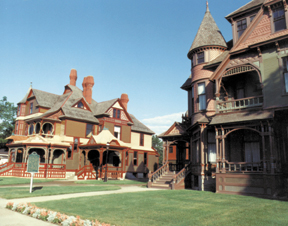
Hackley and Hume Homes
The names Hackley and Hume pepper the landscape; Charles Hackley and partner Thomas Hume were the prime lumber barons. Here’s a picture of their adjacent homes.
We spent the most time in the Lakeshore Museum. The museum itself explores the lifecycle of the area over the past half-billion years or so – it’s been under water for much of its life and it once meandered south of the equator. Several lovely dioramas were created by the Works Project Administration, which apparently put many artists, as well as artisans, to work in the 1930’s Fauna from the woolly mammoth to the barn owl were displayed.
- Long ago…
- Mr. Owl
- Mr. Beaver
- Early neighbor
- Diorama 1
- Diorama 2
- Diorama 3
- Life and times…
Hackley Park is less than a block away. It was created to memorialize the War between the States. It opened in 1892, the day of the dedication of its centerpiece, a 76 foot soldiers and sailors monument. In its center, a 14-foot bronze “goddess of victory” atop a granite pylon, holding a flag and sword (pictured). She is surrounded by a sailor, infantryman, cavalryman and artillery man. At the corners of the city-block sized park are four additional bronze statues: Pres. Lincoln, Adm. Farragut, Gen. Grant and Gen. Sherman. The Museum has several annexes.
Time expired before we could explore the campus of Hackley/Hume homes. But we did visit two others. The Scolnik House, named for the real owners of the house, represents the Depression Era, when the market declined 75% and 25% of the nation was unemployed. The storyline in which the home lives today is that it was owned by a Polish Catholic family who converted it into a two family to make ends meet, leasing the upstairs to a family of Polish Jews escaping the Holocaust. Our guide put us clearly in the situation as she took us through the humble Queen Anne structure.
Next door is the C.H. Hackley Hose Co. No. 2 , a.k.a. the Fire House Museum. It is a reconstruction, built as part of the bicentennial celebration. Its artifacts, however, are authentic. Upstairs is the bunk room, complete with the requisite fire pole. On the main floor were two horse stalls which, when opened, put their “engines” within a few feet of their tack, hung and prepared for instant harnessing. A “modern” motor driven engine stood ready, and a jumping net was displayed over it. Above the stables was a pompier ladder, a device that allowed the fighters to break a window on the floor above, hook to the sill, and climb to rescue the damsel in distress.
- Early “engine”
- Harness at the ready
- A “modern” engine
- Firemen’s quarters
- Pompier Ladder
- You’ll have to jump!
This, and a scenic drive to the harbor and channel where the waters of Muskegon flow into Lake Michigan, was the most we could get to do in one day. Pity!
As a bonus, I got to visit with one of my former database clients, John Worsley. John was Director of Marketing at Performance Bicycle in North Carolina, and I loved to go down to Raleigh and visit my favorite good ol’ boy. John moved out of the Tarheel State almost a decade ago, and I found him in Grand Rapids, thanks to LinkedIn. We hadn’t seen each other for over fifteen years, and we did a lot of catching up – and clue-ing Dot in – over a long lunch downtown. He’s now a confirmed Michigander and, as usual, a font of local –and industry — knowledge! (I was really only interested in the former!)
Grand Rapids and environs was a new and very interesting venue for us. But now it was time to join our Maryland club at our annual long-distance adventure. This was the first time in four years that we’d been able to.

